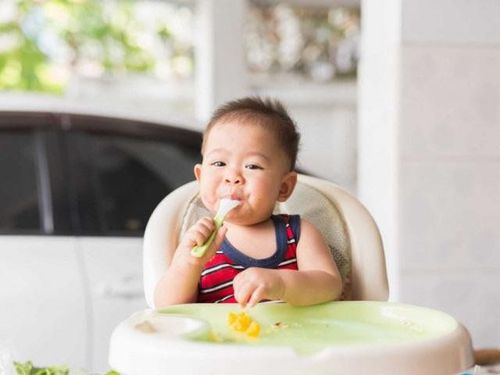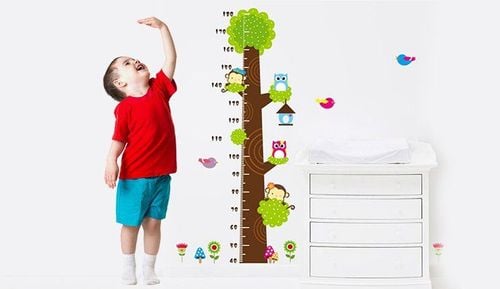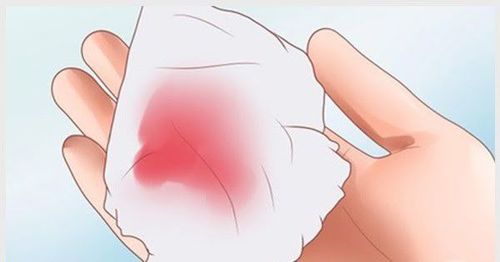This is an automatically translated article.
The article was professionally consulted by Specialist Doctor I, Resident Doctor Dang Thi Ngoan - Pediatrician - Neonatologist, Department of Pediatrics - Neonatology - Vinmec Ha Long International General HospitalBowel legs are a common anomaly in infants and young children, failure to detect and treat early will leave many difficulties in daily life and may cause children to have low self-esteem later on. So how do you know if your child has bow legs?
1. Bowed legs in children
Bowel legs, also known as bent legs, O-shaped legs is an abnormal condition in the legs, common in young children. Accordingly, even when pressing the two ankles close to each other, the two knees are still facing away from each other.In fact, most children with bow legs do well. The cause of this deformity may be due to the wrong position of the fetus in the womb, gradually as the child grows, the legs will return to normal without any impact. For parents, massaging or adjusting children's feet has no effect at all.
It's perfectly normal for an infant's legs to appear bent, so if the baby stands up with toes forward and ankles touching, their knees won't touch. You may notice more bowing as your child begins to stand and walk, but usually the legs gradually straighten out. In some cases, by the age of 3, the child no longer has bow legs. And by the age of 7 or 8, most children's legs have reached the angle they will hold as adults.
The cause of bow legs can be Blount's disease, a bone disorder affecting the shins. Or because vitamin D deficiency occurs in children, and even bow legs can be caused by genetic factors, but this case is quite rare.
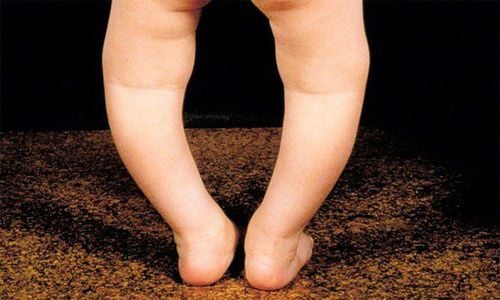
2. How to know if a child has bow legs?
If the child stands with the toes facing forward, the ankles touching and there is a gap between the knees, in this case, the child's legs are bent. If the child's knees touch but the ankles do not touch, the child has been bent. (This condition manifests itself most clearly between the ages of 3 and 6. Like bow legs, this will usually correct itself.)Also, there is another simple way to check for a child's condition. Bowel legs or not by having the child lie on his back, straighten his legs, and touch his ankles. Then, measure the distance between the two knees, this distance is less than 10cm, meaning the child is still developing normally. If the distance between the two knees is more than 10cm, you should take the child to the doctor for a more accurate examination and appropriate and timely treatment.
Besides, there are some cases where it is necessary to conduct a blood test to rule out rickets.
In some cases, X-ray should be performed on the child:
Children 3 years of age and older Bowing behavior in the child is getting worse The bowing on both sides is not the same Test results indicate another problem
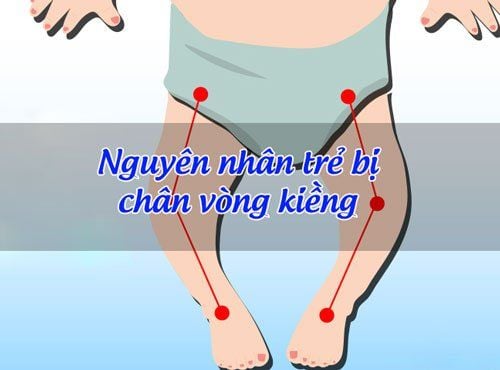
3. Causes of bow legs in children
Many fathers and mothers believe that holding armpits is one of the causes of bow legs in children. However, this reasoning is not entirely correct.Bows are classified into 2 types, including pathological bows and physiological bows. For physiological bows, it will correct itself over time without intervention (usually up to 2 years of age). For pathological bow legs, the causes of this phenomenon may include:
Genetic factors: This is also a cause of bow legs in children, although quite rare. Due to genetic reasons, there is usually no cure. The family can take the child to the orthopedic department for advice on corrective surgery for the baby in cosmetic cases. However, for this method, it is necessary to wait for the baby to grow up to a certain age to intervene. Due to the child's weight: Some children are taught to walk too early (7-9 months) or children are overweight is also the cause of bow legs. At this time, children are still small and their bones are not strong enough to support the entire body weight, so early learning to walk, especially overweight children, will increase the risk of foot problems. bracelet. Some other diseases: In addition, the condition of bow legs in children can be caused by a number of diseases, such as vitamin D deficiency for a long time, vitreous bone disease or brittle bone disease, tangles growth disorder makes bones unable to develop... When seeing any abnormal signs of a child, parents need to take the child immediately to a medical facility for timely examination and treatment.
4. What to do when a child's legs are found to be bowled?
Parents need to perform the above test, if they observe that their child has bowing, they need to see if the bow leg condition is within normal limits. If the results are normal, it means that the baby is still developing well, then you can rest assured, and it is necessary to monitor the child's development. If necessary, the child can be taken to a large and reputable medical facility to be diagnosed with the cause and monitor the progress of the bow legs once every 3 to 6 months in case the gap between 2 knee greater than 10cm.For an infant or toddler, bowing is probably normal. But if you're concerned, get your doctor checked.
Legs will still be a little bit bent if the child is only 2 years old, but some improvement is needed from the toddler stage. If your child is 3 years old and the condition is still evident, you should take the child to the doctor to be checked.
If the cause of your child's bow legs is a vitamin deficiency, the doctor will prescribe supplements. You can take your child to a chiropractor for further evaluation and treatment. Although quite rare, some cases require surgery to correct if the bent leg is severe.
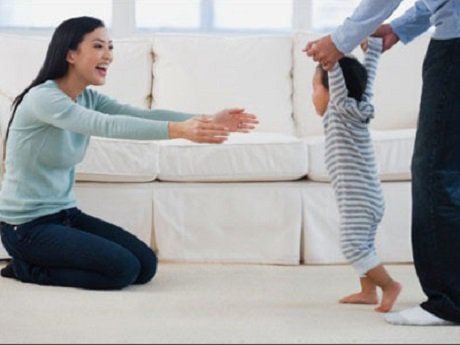
5. Fix bow legs for children
Here are some measures to help you overcome bow legs in children:Parents themselves need to know the knowledge related to this problem to help their children overcome bow legs. In order to clearly identify the disease you are experiencing in your child, you can search for information about your baby's developmental milestones and physiological and pathological changes, thereby minimizing the risk of complications. unpredictable symptom. Although bow legs will improve over time, you need to know when to take your child to the doctor. For example: A child with a limp Child is uncomfortable when under moderate to heavy pressure After a while, the child's legs become more curved After 5-7 years of age, bow legs begin to develop faster. Applying the right nutrition for children: with a healthy and nutritious diet will reduce the risk of developing bone problems such as bone deformities, and prevent the recurrence of attacks. Inflammation destroys joint cartilage. Certain vitamins are essential for the normal development of children with bow legs, such as calcium, vitamin D, proteins and minerals. It is necessary to apply a menu with enough nutrients without causing overweight in children. Take timely treatment measures: Letting the child wear a brace at night is a way to overcome bow legs in children. This form is often used by pediatricians for the purpose of early management of the condition. As children get older, most forms of bow legs improve, but therapists recommend that for early recovery, you should take your child to multiple treatments with holistic methods. Massage therapy is also very helpful in treating this deformity. Many experts believe that it may take a longer time for children to treat their bow legs with massage and correction, but if started at an early stage, this method will help reduce the condition of the legs. when children grow up. Do exercises for children with bow legs : to control bow legs in children , parents can let children do some exercises - These exercises help the muscles and soft connective tissues of the child . The body reassembles the structure. In addition, the exercise also helps children improve internal strength and restore standing posture, while enhancing flexibility in the legs for children. Control your child's body weight: Controlling your child's weight is an effective way to overcome bow legs. Some studies show that, when children have bow legs, bones and connective tissues are under stress, pressure due to uneven distribution and joints. Therefore, the child's bones will be overloaded when the child is overweight, leading to deformed lower limbs. Parents need to encourage their children to practice healthy eating habits, limit snacking and promote normal physical activity to minimize excess weight gain in children. In addition, the child's knee joint is at high risk of injury, causing bow legs when the child is overweight. If someone in the family has a bone disorder, the risk is even higher.
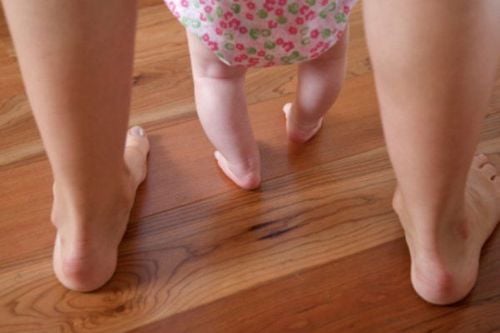
Children can experience many complications such as arthritis, discomfort when walking, bent knees if the condition of bow legs is not corrected. Therefore, you should take your child to the doctor if you notice signs that your child has bow legs or suspect that your child has this condition.
If the child shows signs of bowing, parents should send their child to the Pediatric Orthopedic specialist - Vinmec International General Hospital to be examined by a qualified doctor.
With a team of well-trained, highly qualified, experienced and dedicated doctors and nurses at the hospital, will advise and take care of customers with effective methods of diagnosis and treatment. most effective and advanced today.
Please dial HOTLINE for more information or register for an appointment HERE. Download MyVinmec app to make appointments faster and to manage your bookings easily.
Source: babycenter.com





